7/4/2008 (Fri)
Jamaica Bay Wildlife Refuge
tree swallow
8/1/2009 (Sat) morning
Oceanside
... ... tree swallows (adults and 2 young ones standing on the iron fence, 鐵網柵欄)
and probably barn swallows, ... ...
4/24/2010 (Sat) 9:30am-12:30pm
Jamaica Bay Wildlife Refuge with Sam Pang
White-throated sparrows,
tree swallows, ... ... (may have pictures; check folder in home desktop PC)
5/29/2010 (Sat) pm
Jamaica Bay Wildlife Refuge
Singing video
/ picture :
catbird, tree swallow,
crow,
Carolina wren myNote
Foraging/feeding
video / picture :
male tree swallow
peeks and guards the box during incubation (Male does not feed incubating
female, but will often perch near or at nest site when female is absent. (Kuerzi
1941). learn more
here or the mirror and
PRBO Conservation Science)
myVideo: 1
2
crow steals eggs or kills babies so chased and attacked by tree
swallows and red-winged blackbirds. learn more
here .
/31/2010 (Mon) pm
Jamaica Bay Wildlife Refuge
Tree swallow really close-up and
video - probably a 1st year male. Taken at a wren nest
box.
6/5/2010 (Sat) 10:15am-12:45pm
Jamaica Bay Wildlife Refuge with Megan
The tree swallow seen in the wren nest box and the standing Canada goose on empty
nest on Memorial long weekend were still there. Eastern Towhee
dark-eyed ("Oregon") junco, house finch, yellow-crowned night herons,
etc. No oystercatcher found.
6/12/2010 (Sat) morning
Oceanside
black-crowned night herons, yellow-crowned night herons, green herons, great egrets,
gulls, terns, tree swallows (inc. a juvenile peeking out of the box), barn swallow,
red-winged blackbirds (males and female),
Starlings, killdeers, song sparrows, unknown sparrows (perhaps saltmarsh
sharp-tailed or seaside), many willets, osprey parents feed babies on the nest.
Using the burst mode of the camera Panasonic FZ35 to take many pictures.
Enjoy this slide-show video.
6/13/2010 (Sun) morning
Willow Lake Nature Trail, Flushing Meadows-Corona Park
... ... barn swallows, red-winged blackbirds, mourning doves, etc.
6/20/2010 (Sun) afternoon
Jamaica Bay Wildlife Refuge (JBWR)
Grackle was attacked by tree swallows. "Common
Grackles eat other birds' eggs and nestlings, and occasionally kill and eat other
adult birds" (source
here, read also this
and this; Mirror of
birds.cornell.edu) ... ... (have video;
check folder in home desktop PC)
Don't male
Tree Swallows incubate?
- No,
as in many songbirds, only female
Tree Swallows
incubate.
- Females develop special
temporary structures
called brood patches for transfer
of
heat
to eggs.
- Hormones cause a
large area of breast and belly skin
to lose its feathers.
This
skin
becomes
loose and
swollen through
water retention
and expansion of
blood vessels.
- As she settles onto her eggs
an incubating female presses her
bare brood patch
skin
firmly
onto them,
creating an efficient contact for
transfer of her
body
heat to the eggs.
- The brood patch below is typical
of Tree Swallows.

When
(after which egg is laid) do Tree Swallow females start incubating?
- You'll
get the answer when the
eggs
finally
hatch.
- If incubation
starts with the first
egg, they will hatch one
per day over
several
days.
- If incubation
doesn't start
until after all
eggs
are laid, they
should all hatch
the
same day.
- Incubation
could also
start somewhere in between
these extremes.
How
can you tell incubation has started?
There are behavioral
cues. For example:
- Females
begin staying
inside boxes many minutes. Try
timing
some.
- Incubating females develop
a rhythm. Periods on the
eggs alternate
with
periods off. They feed
quickly and then return
to the eggs.
- In songbirds
like Tree Swallows, where only females incubate,
females average
75-80% of daylight hours on their
eggs.
- If
weather is cold or rainy females incubate even longer,
because eggs
need
extra heat to maintain temperatures
necessary for embryonic
development.
Here's
another way to tell if incubation has started:
- Touch an
egg from each clutch to your lips
or cheek. If it's
cool, it isn't
being
incubated. If warm,
incubation has probably
started.
How
long does incubation last? When will eggs hatch?
- Tree Swallow eggs
need about
14 days of incubation for
embryo growth
and
development to
reach the hatching
stage.
Songbird
eggs lose about 20% of their weight between laying and hatching. Why?
- Some weight
is lost as fuel is burned during
embryonic metabolic
processes.
- Some water
evaporates through shell membranes and
shell, and is
replaced by
air
from outside.
- The air
space in the egg get larger as incubation
proceeds.
How
do fats, proteins, minerals and water get from the yolk and albumen to the
growing embryo?
- A network
of blood vessels (arteries, veins, and capillaries) grow out
from the
developing embryo,
and bring back the nutrients necessary for
development.
- Click here
to view a
photo of a fertile Tree Swallow egg being "candled".
This
egg has been incubated a few days
and clearly shows the web of blood vessels
extending out from the small embryo on the
surface of the yolk.
How
does an embryo "breathe" within its shell?
- Songbird eggshells are not
completely solid. The shells have
microscopic pores
through which oxygen and carbon dioxide
gases can pass in and out.
- Also, as an embryo grows a
special membrane, the "CAM"
or "Chorioallantoic
Membrane",
develops just under the inner shell
membrane.
- The
CAM has lots of capillaries where blood can absorb airborne oxygen
that
has passed in through the shell pores.
- Carbon
dioxide waste produced by embryonic metabolism can be also
passed in
the other direction, from the CAM's blood out through
the shell pores.
How
does a growing embryo get rid of solid wastes it produces?
- The embryo produces a
membranous sac, called the
"Allantois",
that balloons
out
from
the embryo's gut.
- As the embryo grows solid
wastes that can't pass through the shell are diverted
into this sac,
where they accumulate.
- Just before
hatching the wastes in the allantois dry up.
Incubating
songbirds turn eggs over periodically with their bills. How is this done
and why?
- When turning its eggs
an incubating bird rises up on its legs,
arches its neck so
its head looks down, then draws its bill backwards
through the
eggs. This
motion rearranges the eggs so those out on the outside are
brought into the
middle.
- Regular turning ensures that
all eggs in the clutch are incubated evenly
and
that all surfaces of
each egg receive equal warmth.
- Turning
also
moves an
egg's contents,
keeping membranes
and embryo from
sticking to
interior shell
surfaces,
which could
cause embryo
death.
- Songbirds may turn their eggs
as often as seven to eight times an hour.
What
happens to the eggs at night?
- Before incubation neither
male or female swallows
stay in boxes
at
night unless
it's extremely cold. They
usually roost in
nearby trees,
shrubs or marsh
vegetation.
- However,
once incubation starts females stay in
boxes overnight.
- Staying in cavities overnight
is dangerous. Females can be
trapped in boxes
that lack predator guards
by
nocturnal predators like raccoons,
possums, or
cats.
Female
Tree Swallows are very busy now incubating and foraging. It seems they do
all the work. What do male Tree Swallows do during incubation? Are
males and
females together often at boxes now?
- During incubation it's
typical to see pair members relieving each other
at the
nests. Males
guard boxes
while females
leave to feed.
- Although
males don't incubate, they may perch at holes and peek
in,
or
enter,
perhaps to "inspect" things.
- Male Tree Swallows don't bring
food to females during incubation or at any
other time.
- More often males perch on
boxes or poles,
preening and giving
occasional
Songs to passing swallows.
Chatter
Calls aren't heard
much now, except if
floater females approach and males
want to attract them.
- Nest females
usually fly directly to the hole and duck right into boxes.
- Returning
swallows often give Gurgles
(also called Contact Calls).
At
this signal
the other normally
leaves, so a pair are
seldom together.
- Females who
have
finished
an interval of incubating, but whose males
haven't
returned yet, may perch in entrances
waiting to be relieved.
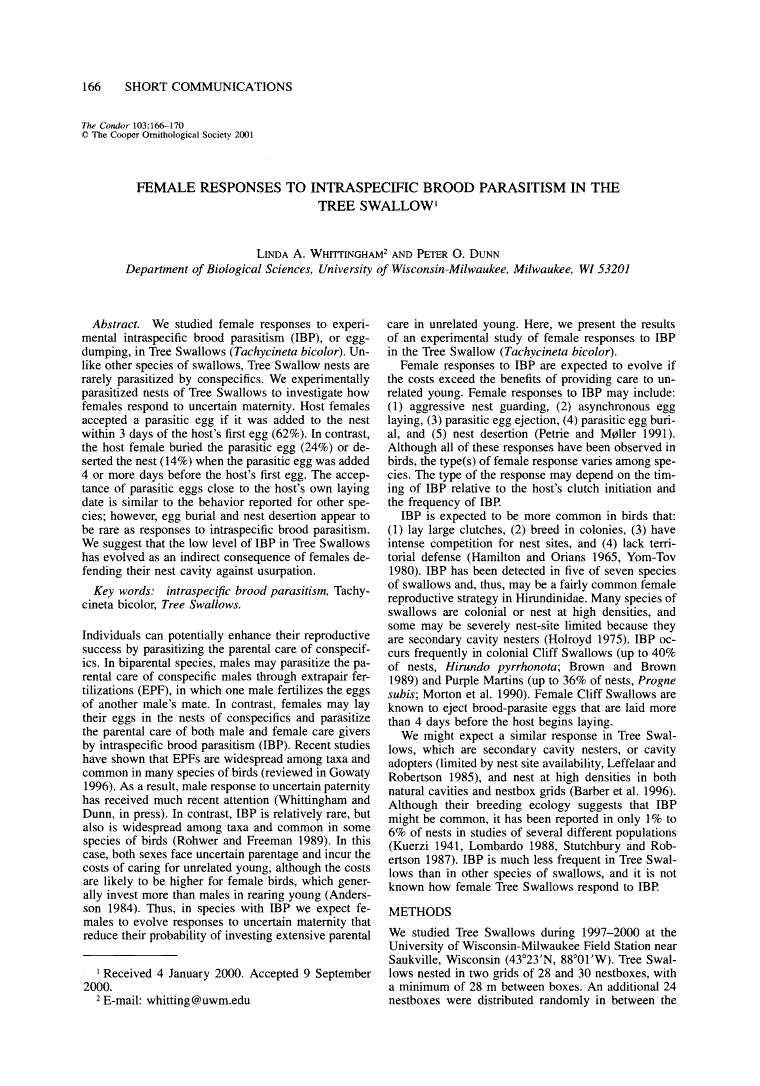
usurpation =
篡奪
transitive verb 1 a :
to seize and hold (as office, place, or powers) in possession by force or
without right <usurp a throne> b
: to take or make use of without right
<usurped the rights to her life story>
2 : to take the place of by or as if by
force :
supplant
<must not let stock responses based on inherited prejudice
usurp careful judgment>
intransitive verb : to seize or exercise
authority or possession wrongfully
Hirundinidae:
The swallows and martins are a group of passerine birds in the family
Hirundinidae which are characterised by their adaptation to aerial
feeding.
http://en.wikipedia.org/wiki/Swallow
|
Science 4 May 1984:
Vol. 224. no. 4648, pp. 518 - 519
DOI: 10.1126/science.224.4648.518
|
|
Articles
Laying Eggs in a
Neighbor's Nest:
Benefit and Cost of
Colonial Nesting in
Swallows
CHARLES R. BROWN
1
1
Department of
Biology, Princeton
University,
Princeton, New
Jersey 08544
Intraspecific
brood parasitism
(laying eggs in
another's nest)
occurs
widely in
colonial
cliff swallows
(Passeriformes:
Hirundinidae:
Hirundo
pyrrhonota). In
colonies
consisting of
more than ten
nests, up
to 24 percent of
the nests were
sometimes
parasitized
by colony
members. Laying
eggs in a
conspecific's
nest may be
a benefit
of coloniality
for parasitic
individuals and
simultaneously
may
represent a cost
to host
individuals
within the same
colony.
Submitted on
November 30, 1983
Accepted on March 8,
1984
google: IBP five of seven species of swallows
Answer: bank, barn, cave, cliff
&
tree.
7 swallows: bank, barn, cave, cliff,
tree, violet-green, and northern
rough-winged.
How about Purple Martin? Yes, it is IBP; up to 36% of nests
parasited.
Bahama swallow?
Intraspecific nest parasitism was relatively frequent (overall 16·5% of
261 nests) among barn swallows, Hirundo rustica.
http://www.sciencedirect.com/science?_ob=ArticleURL&_udi=B6W9W-4JT84SP-11&_user=10&_coverDate=02%2F28%2F1987&_rdoc=1&_fmt=high&_orig=search&_sort=d&_docanchor=&view=c&_searchStrId=1379940582&_rerunOrigin=google&_acct=C000050221&_version=1&_urlVersion=0&_userid=10&md5=99c59d4343780ccfe48880d8ad211dfc
In
Anglophone Europe, barn swallow is just called the Swallow; in
Northern Europe it is the only common species called a "swallow" rather
than a "martin".
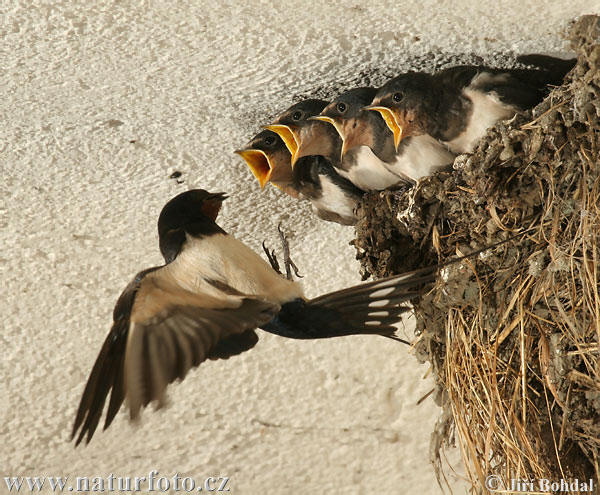
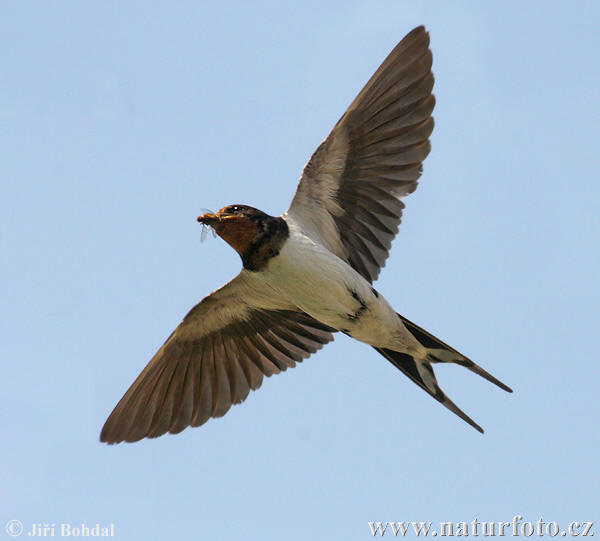
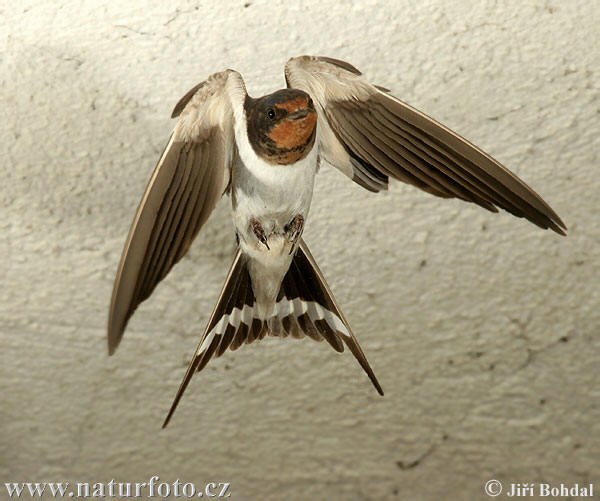
more swallow pictures
The Sand Martin (Riparia riparia) is a
migratory
passerine bird
in the swallow
family. It has a wide range in summer, embracing practically the whole of
Europe and the
Mediterranean countries, part of northern
Asia and also
North
America. It winters in eastern and southern
Africa,
South
America and
South Asia.
It is known as Bank Swallow in North America, and as Collared Sand
Martin in South Asia, and sometimes as European Sand Martin..
"Brood
parasitism in the sand martin,Riparia riparia: evidence for two parasitic
strategies in a colonial passerine"
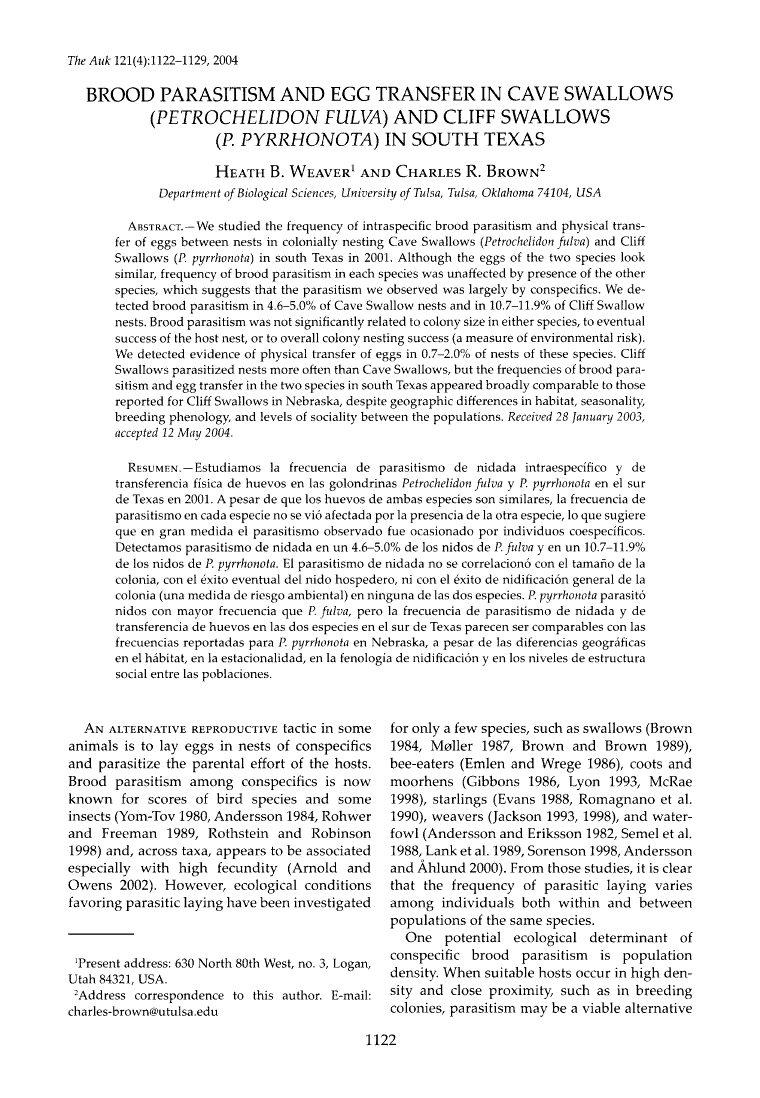
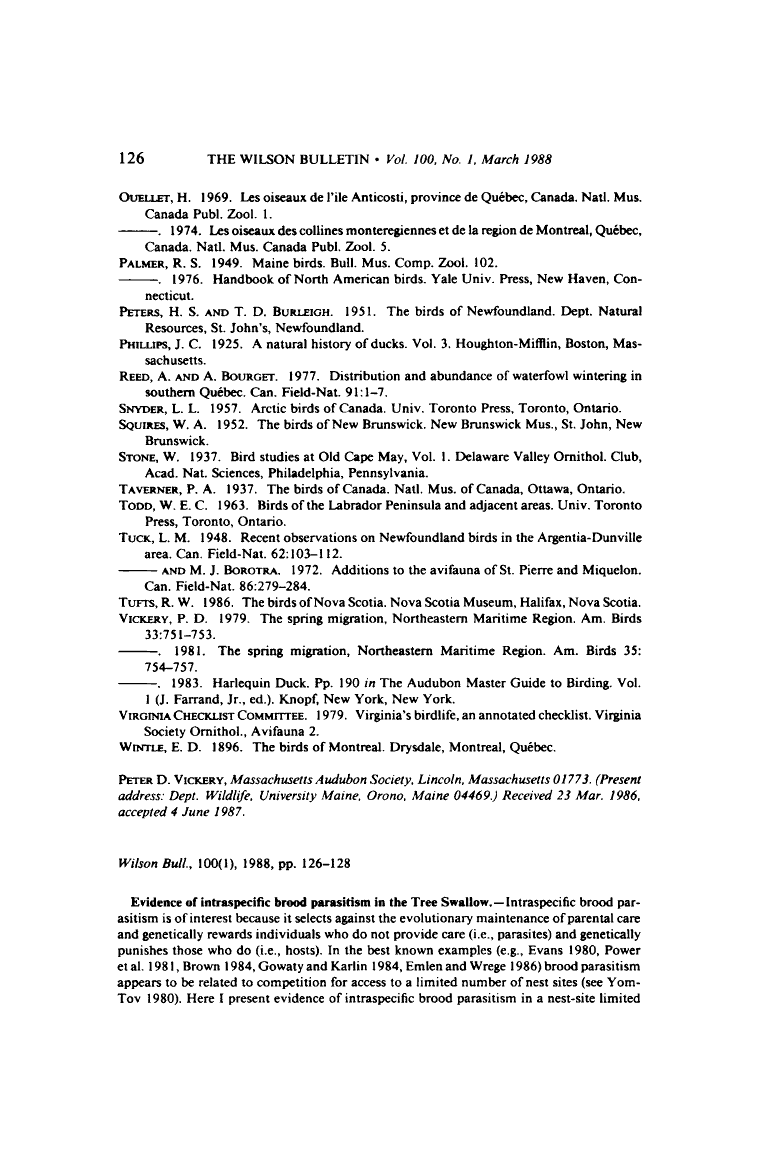
The Wilson Journal of Ornithology 119(1):126-128. 2007
doi: 10.1676/05-156.1
Interspecific Egg-dumping by a Violet-green
Swallow in an Active Western Bluebird Nest
Danika Kleiber1,2,6,
Jenne Turner1,3,
Amber E. Budden1,4,
and Janis L. Dickinson1,5
1011Hastings
Natural History Reservation, 38601 E. Carmel Valley Rd., Carmel Valley, CA
93924, USA
1022University
of British Columbia, Department of Forest Sciences, Forest Sciences Centre,
2424 Main Mall, Vancouver, BC V6T 1Z4, Canada
10331420
Walnut St., Ste. 650, Philadelphia, PA 19102, USA
1044Department
of Zoology, University of Toronto, 25 Harbord St., Toronto, ON M5S 3G5,
Canada
1055Cornell
Laboratory of Ornithology, 159 Sapsucker Woods Rd., Ithaca, NY 14850, USA
1066Corresponding
author; danika@ekit.com
Abstract
We observed a Violet-green Swallow (Tachycineta
thalassina) laying an egg in an active Western Bluebird (Sialia
mexicana) nest. The Western Bluebird male and not the
female, was aggressive to the Violet-green Swallow but the
swallow remained to lay the egg. This is the first documented
incidence of which we are aware involving altricial
interspecific egg-laying during the nestling phase. We suggest
the timing of this event was more consistent with incidental egg
deposition, or egg-dumping, than brood parasitism or nest
usurpation.
Received: December 13, 2005;
Accepted: July 24, 2006
LITERATURE CITED
Bailey, H. B. 1886.
The Brown Thrush laying in the nest
of the Wood Thrush. Auk 4:78.
Brawn, J. D.
1990.
Interspecific competition and social
behavior in Violet-green Swallows. Auk 107:
606–
608.
CSA
Brown, C. R., A. M. Knott, and E. J. Damrose.
1992. Violet-green Swallow (Tachycineta
thalassina). The birds of North America. Number 14.
Cannell, P. F. and B. A. Harrington.
1984.
Interspecific egg dumping by a Great
Egret and Black-crowned Night Herons. Auk 101:
889–
891.
CSA
Carter, M. D.
1987.
An incident of brood parasitism by
the Verdin. Wilson Bulletin 99:
136.
CSA
Dickinson, J. L., W. D. Koenig, and F. A. Pitelka.
1996.
Fitness consequences of helping behavior in the Western Bluebird.
Behavioral Ecology 7:
168–
177.
CrossRef,
CSA
Eltzroth, E. K. and S. R. Robinson.
1984.
Violet-green
Swallows help Western Bluebirds at the nest. Journal
of Field Ornithology 55:
259–
261.
CSA
Guinan, J. A., P. A. Gowaty, and E. K. Eltzroth.
2000.
Western Bluebird (Sialia mexicana). The birds of North
America. Number 510.
Gustafson, J. R. 1975.
A Sage Sparrow egg in a
Black-throated Sparrow nest. Auk 92:805–806.
Holcomb, L. C. 1967.
Mourning Dove egg in nest of catbird
and robin. Wilson Bulletin 79:450–451.
Leffelaar, D. and R. J. Robertson.
1985.
Nest usurpation and female
competition for breeding opportunities by Tree Swallows.
Wilson Bulletin 97:
221–
224.
CSA
Littlefield, C. D.
1984.
Sandhill Crane incubates a Canada
Goose egg. Wilson Bulletin 96:
719.
CSA
Sealy, S. G.
1989.
Incidental “egg dumping” by the
House Wren in a Yellow Warbler nest. Wilson Bulletin 101:
491–
493.
CSA
Wiens, J. A. 1971.
“Egg-dumping” by the Grasshopper
Sparrow in a Savannah Sparrow nest. Auk 88:185–186.
over 200 species of birds were observed IBP. source:
Conspecific Brood Parasitism in Birds: A Life-History Perspective
An updated list and some comments on the occurrence of intraspecific nest
parasitism in birds
YORAM YOM-TOV 1
1 Department of Zoology, Tel Aviv University, Tel Aviv 69978,
Israel
Copyright 2001 British Ornithologists Union
ABSTRACT
This paper presents a list, compiled from the literature, of bird species in
which intraspecific nest parasitism (INP) occurs. INP was reported in 234
species: one Struthioniformes, two Tinamiformes, two Procellariiformes, six
Podicipediiformes, five Ciconiiformes, one Phoenicopteriformes, 74
Anseriformes雁形目,
one Falconiformes, 32 Galliformes, eight Gruiformes, 19 Charadriiformes,
nine Columbiformes, five Cuculiformes, two Apodiformes, one Coraciiformes
and 66 Passeriformes. Hence, INP is very common among precocial species, and
less so among altricials. Irrespective of this, most INP birds are colonial.
Received 5 August 1999; revision accepted 25 February 2000
Translation:
1 Struthioniformes,2
Tinamiformes,2鹱形目,6
Podicipediiformes,5鸛形目,一Phoenicopteriformes,74雁形目,隼之一,32雞形目,鶴形目八,19鴴形目,9鴿,5鵑形目,2雨燕目,一佛法僧目和66雀形目
雁形目
http://baike.baidu.com/view/129952.htm
雁形目(Anseriformes)在动物分类学上是鸟纲中的一个目。本目的鸟在中文种通常被称为“鸭”或“雁”,包括了人们通常所说的鸭、潜鸭、天鹅、各种雁类等鸭雁类(或雁鸭类)的鸟。本目的鸟都是游禽,在世界分布广泛。
http://www.hudong.com/wiki/%E9%9B%81%E5%BD%A2%E7%9B%AE
http://zh.wikipedia.org/zh-tw/%E9%9B%81%E5%BD%A2%E7%9B%AE







